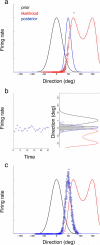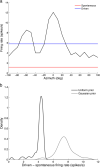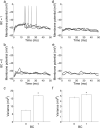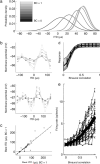Neural representation of probabilities for Bayesian inference
- PMID: 25561333
- PMCID: PMC4372535
- DOI: 10.1007/s10827-014-0545-1
Neural representation of probabilities for Bayesian inference
Abstract
Bayesian models are often successful in describing perception and behavior, but the neural representation of probabilities remains in question. There are several distinct proposals for the neural representation of probabilities, but they have not been directly compared in an example system. Here we consider three models: a non-uniform population code where the stimulus-driven activity and distribution of preferred stimuli in the population represent a likelihood function and a prior, respectively; the sampling hypothesis which proposes that the stimulus-driven activity over time represents a posterior probability and that the spontaneous activity represents a prior; and the class of models which propose that a population of neurons represents a posterior probability in a distributed code. It has been shown that the non-uniform population code model matches the representation of auditory space generated in the owl's external nucleus of the inferior colliculus (ICx). However, the alternative models have not been tested, nor have the three models been directly compared in any system. Here we tested the three models in the owl's ICx. We found that spontaneous firing rate and the average stimulus-driven response of these neurons were not consistent with predictions of the sampling hypothesis. We also found that neural activity in ICx under varying levels of sensory noise did not reflect a posterior probability. On the other hand, the responses of ICx neurons were consistent with the non-uniform population code model. We further show that Bayesian inference can be implemented in the non-uniform population code model using one spike per neuron when the population is large and is thus able to support the rapid inference that is necessary for sound localization.
Figures





Similar articles
-
Adaptation in the auditory space map of the barn owl.J Neurophysiol. 2006 Aug;96(2):813-25. doi: 10.1152/jn.01144.2005. Epub 2006 May 17. J Neurophysiol. 2006. PMID: 16707713
-
Response adaptation in the barn owl's auditory space map.J Neurophysiol. 2018 Mar 1;119(3):1235-1247. doi: 10.1152/jn.00769.2017. Epub 2017 Dec 27. J Neurophysiol. 2018. PMID: 29357460
-
Representation of temporal features of complex sounds by the discharge patterns of neurons in the owl's inferior colliculus.J Neurophysiol. 2000 Nov;84(5):2638-50. doi: 10.1152/jn.2000.84.5.2638. J Neurophysiol. 2000. PMID: 11068005
-
The synthesis and use of the owl's auditory space map.Biol Cybern. 2003 Nov;89(5):378-87. doi: 10.1007/s00422-003-0443-5. Epub 2003 Dec 4. Biol Cybern. 2003. PMID: 14669018 Review.
-
Binaural processing in the synthesis of auditory spatial receptive fields.Biol Cybern. 2003 Nov;89(5):371-7. doi: 10.1007/s00422-003-0442-6. Epub 2003 Nov 4. Biol Cybern. 2003. PMID: 14669017 Review.
Cited by
-
Neural tuning instantiates prior expectations in the human visual system.Nat Commun. 2023 Sep 1;14(1):5320. doi: 10.1038/s41467-023-41027-w. Nat Commun. 2023. PMID: 37658039 Free PMC article.
-
Single trial Bayesian inference by population vector readout in the barn owl's sound localization system.PLoS One. 2024 May 21;19(5):e0303843. doi: 10.1371/journal.pone.0303843. eCollection 2024. PLoS One. 2024. PMID: 38771860 Free PMC article.
-
Investigating the representation of uncertainty in neuronal circuits.PLoS Comput Biol. 2021 Feb 12;17(2):e1008138. doi: 10.1371/journal.pcbi.1008138. eCollection 2021 Feb. PLoS Comput Biol. 2021. PMID: 33577553 Free PMC article.
-
Synthesis of Hemispheric ITD Tuning from the Readout of a Neural Map: Commonalities of Proposed Coding Schemes in Birds and Mammals.J Neurosci. 2019 Nov 13;39(46):9053-9061. doi: 10.1523/JNEUROSCI.0873-19.2019. Epub 2019 Sep 30. J Neurosci. 2019. PMID: 31570537 Free PMC article.
-
Development of a Bayesian Estimator for Audio-Visual Integration: A Neurocomputational Study.Front Comput Neurosci. 2017 Oct 4;11:89. doi: 10.3389/fncom.2017.00089. eCollection 2017. Front Comput Neurosci. 2017. PMID: 29046631 Free PMC article.
References
-
- Albeck Y, Konishi M. Responses of neurons in the auditory pathway of the barn owl to partially correlated binaural signals. Journal of Neurophysiology. 1995;74:1689–1700. - PubMed
-
- Anderson CH, Van Essen DC. Neurobiological computational systems. Computational Intelligence Imitating Life. 1994:213–222.
-
- Arthur BJ. Sensitivity to spectral interaural intensity difference cues in space-specific neurons of the barn owl. Journal of Comparative Physiology A. 2004;190:91–104. - PubMed
-
- Bala ADS, Spitzer MW, Takahashi TT. Prediction of auditory spatial acuity from neural images on the owl's auditory space map. Nature. 2003;424:771–774. - PubMed
-
- Barber MJ, Clark JW, Anderson CH. Neural representation of probabilistic information. Neural Computation. 2003;15:1843–1864. - PubMed
Publication types
MeSH terms
Grants and funding
LinkOut - more resources
Full Text Sources
Other Literature Sources

